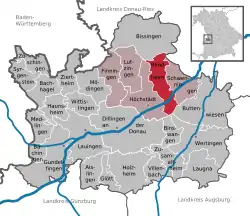Blindheim
Blindheim (German: [ˈblɪnthaɪm]), traditionally known in English as Blenheim (/ˈblɛnɪm/ BLEN-im), is a municipality in the Bavarian district of Dillingen in southern Germany, consisting of several villages. It is north of Augsburg, on the left bank of the Danube River. Its population is roughly 1,700.
Blenheim
Blindheim | |
|---|---|
 Church of Saint Martin | |
 Coat of arms | |
Location of Blenheim within Dillingen district  | |
 Blenheim  Blenheim | |
| Coordinates: 48°38′N 10°38′E | |
| Country | Germany |
| State | Bavaria |
| Admin. region | Schwaben |
| District | Dillingen |
| Government | |
| • Mayor | Jürgen Frank (Freie Bürgerliste) |
| Area | |
| • Total | 26.39 km2 (10.19 sq mi) |
| Elevation | 415 m (1,362 ft) |
| Population (2019-12-31)[1] | |
| • Total | 1,694 |
| • Density | 64/km2 (170/sq mi) |
| Time zone | UTC+01:00 (CET) |
| • Summer (DST) | UTC+02:00 (CEST) |
| Postal codes | 89434 |
| Dialling codes | 09074 |
| Vehicle registration | DLG |
| Website | www.blindheim.de |
For administrative purposes, it is affiliated with the municipal association of Höchstädt an der Donau.
Since about 1700 the Lordship of Blindheim in the Electorate of Bavaria has been held by the Counts of Rechberg.
On 13 August 1704 the Battle of Blenheim (German: Schlacht von Höchstädt) was fought in the vicinity, having decisive importance on the War of Spanish Succession. Blenheim Palace in England was named in memory of the battle, and thus ultimately after Blindheim.
In June 1800, the armies of the French First Republic, under command of Jean Victor Moreau, fought Habsburg regulars and Württemberg contingents, under the general command of Pál Kray. At this battle, the culmination of the Danube Campaign of 1800, Moreau forced Kray to abandon Ulm and withdraw into eastern Bavaria.[2]
See also
References
- "Tabellenblatt "Daten 2", Statistischer Bericht A1200C 202041 Einwohnerzahlen der Gemeinden, Kreise und Regierungsbezirke". Bayerisches Landesamt für Statistik und Datenverarbeitung (in German). July 2020.
- "Höchstädt", History of the Wars of the French Revolution: Including Sketches of the Civil History of Great Britain and France, from the Revolutionary Movements, 1788, to the Restoration of a General Peace, 1815, Kuhl, France, 1820, p. 183.
